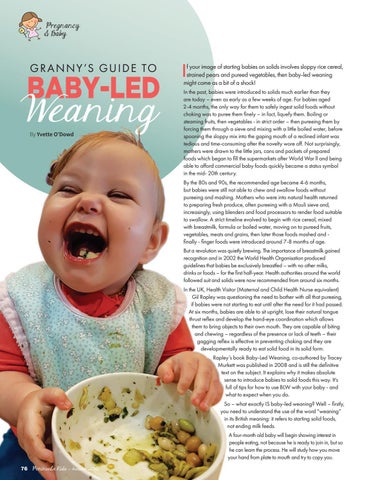Pregnancy & Baby
G R A N N Y ’S G U I D E TO
BABY-LED
Weaning By Yvette O’Dowd
I
f your image of starting babies on solids involves sloppy rice cereal, strained pears and pureed vegetables, then baby-led weaning might come as a bit of a shock!
In the past, babies were introduced to solids much earlier than they are today – even as early as a few weeks of age. For babies aged 2-4 months, the only way for them to safely ingest solid foods without choking was to puree them finely – in fact, liquefy them. Boiling or steaming fruits, then vegetables - in strict order – then pureeing them by forcing them through a sieve and mixing with a little boiled water, before spooning the sloppy mix into the gaping mouth of a reclined infant was tedious and time-consuming after the novelty wore off. Not surprisingly, mothers were drawn to the little jars, cans and packets of prepared foods which began to fill the supermarkets after World War ll and being able to afford commercial baby foods quickly became a status symbol in the mid- 20th century. By the 80s and 90s, the recommended age became 4-6 months, but babies were still not able to chew and swallow foods without pureeing and mashing. Mothers who were into natural health returned to preparing fresh produce, often pureeing with a Mouli sieve and, increasingly, using blenders and food processors to render food suitable to swallow. A strict timeline evolved to begin with rice cereal, mixed with breastmilk, formula or boiled water, moving on to pureed fruits, vegetables, meats and grains, then later those foods mashed and finally - finger foods were introduced around 7-8 months of age. But a revolution was quietly brewing. The importance of breastmilk gained recognition and in 2002 the World Health Organisation produced guidelines that babies be exclusively breastfed – with no other milks, drinks or foods – for the first half-year. Health authorities around the world followed suit and solids were now recommended from around six months. In the UK, Health Visitor (Maternal and Child Health Nurse equivalent) Gil Rapley was questioning the need to bother with all that pureeing, if babies were not starting to eat until after the need for it had passed. At six months, babies are able to sit upright, lose their natural tongue thrust reflex and develop the hand-eye coordination which allows them to bring objects to their own mouth. They are capable of biting and chewing – regardless of the presence or lack of teeth – their gagging reflex is effective in preventing choking and they are developmentally ready to eat solid food in its solid form. Rapley’s book Baby-Led Weaning, co-authored by Tracey Murkett was published in 2008 and is still the definitive text on the subject. It explains why it makes absolute sense to introduce babies to solid foods this way. It's full of tips for how to use BLW with your baby - and what to expect when you do. So – what exactly IS baby-led weaning? Well – firstly, you need to understand the use of the word “weaning” in its British meaning: it refers to starting solid foods, not ending milk feeds. A four-month old baby will begin showing interest in people eating, not because he is ready to join in, but so he can learn the process. He will study how you move your hand from plate to mouth and try to copy you.
76 76 Peninsula PeninsulaKids Kids––Autumn Winter 2020 2020
